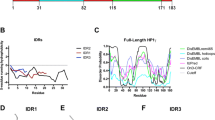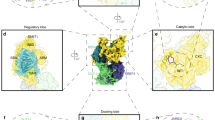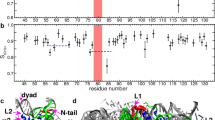Abstract
Context
Ubiquitin-like with PHD and RING finger domain containing protein 1 (UHRF1) is responsible for preserving the stability of genomic methylation through the recruitment of DNA methyltransferase 1 (DNMT1). However, the interaction between Developmental pluripotency associated 3 (DPPA3) and the pre-PHD-PHD (PPHD) domain of UHRF1 hinders the nuclear localization of UHRF1. This disruption has implications for potential cancer treatment strategies. Drugs that mimic the binding pattern between DPPA3 and PPHD could offer a promising approach to cancer treatment. Our study reveals that DPPA3 undergoes dissociation from the C-terminal through three different modes of helix unfolding. Furthermore, we have identified key residue pairs involved in this dissociation process and potential drug-targeting residues. These findings offer valuable insights into the dissociation mechanism of DPPA3 from PPHD and have the potential to inform the design of novel drugs targeting UHRF1 for cancer therapy.
Methods
To comprehend the dissociation process and binding patterns of PPHD-DPPA3, we employed enhanced sampling techniques, including steered molecular dynamics (SMD) and conventional molecular dynamics (cMD). Additionally, we utilized self-organizing maps (SOM) and time-resolved force distribution analysis (TRFDA) methodologies. The Gromacs software was used for performing molecular dynamics simulations, and the AMBER FF14SB force field was applied to the protein.







Similar content being viewed by others
Data availability
Data available on request from the authors.
References
Nishiyama A, Mulholland CB, Bultmann S, Kori S (2020) Two distinct modes of DNMT1 recruitment ensure stable maintenance DNA methylation. Nat Commun 11(1):1222. https://doi.org/10.1038/s41467-020-15006-4
Ishiyama S, Nishiyama A, Saeki Y, Moritsugu K (2017) Structure of the Dnmt1 reader module complexed with a unique two-mono-ubiquitin mark on histone H3 reveals the basis for DNA methylation maintenance, Molecular cell 68(2): 350–360. e7. https://doi.org/10.1016/j.molcel.2017.09.037.
Arita K, Ariyoshi M, Tochio H, Nakamura Y (2008) Recognition of hemi-methylated DNA by the SRA protein UHRF1 by a base-flipping mechanism. Nature 455(7214):818–821. https://doi.org/10.1038/nature07249
Arita K, Isogai S, Oda T, Unoki M (2012) Recognition of modification status on a histone H3 tail by linked histone reader modules of the epigenetic regulator UHRF1. Proc Natl Acad Sci U S A 109(32):12950–12955. https://doi.org/10.1073/pnas.1203701109
Avvakumov GV, Walker JR, Xue S, Li Y (2008) Structural basis for recognition of hemi-methylated DNA by the SRA domain of human UHRF1. Nature 455(7214):822–825. https://doi.org/10.1038/nature07273
Chen Z, Zhang Y (2020) Role of mammalian DNA methyltransferases in development. Annu Rev Biochem 89:135–158. https://doi.org/10.1146/annurev-biochem-103019-102815
Sun J, Liu F, Yuan L, Pang N-N (2023) Mechanism studies of the activation of DNA methyltransferase DNMT1 triggered by histone H3 ubiquitination, revealed by multi-scale molecular dynamics simulations. Science China Life Sciences 66(2):313–323. https://doi.org/10.1007/s11427-021-2179-8
Kikuchi A, Onoda H, Yamaguchi K, Kori S (2022) Structural basis for activation of DNMT1. Nat Commun 13(1):7130. https://doi.org/10.1038/s41467-022-34779-4
Schermelleh L, Haemmer A, Spada F, Rösing N (2007) Dynamics of Dnmt1 interaction with the replication machinery and its role in postreplicative maintenance of DNA methylation. Nucleic Acids Res 35(13):4301–4312. https://doi.org/10.1093/nar/gkm432
Hermann A, Goyal R, Jeltsch A (2004) The Dnmt1 DNA-(cytosine-C5)-methyltransferase methylates DNA processively with high preference for hemimethylated target sites. J Biol Chem 279(46):48350–48359. https://doi.org/10.1074/jbc.M403427200
Greenberg MVC, Bourc’his D (2019) The diverse roles of DNA methylation in mammalian development and disease. Nat Rev Mol Cell Biol 20(10):590–607. https://doi.org/10.1038/s41580-019-0159-6
Li Y, Zhang Z, Chen J, Liu W (2018) Stella safeguards the oocyte methylome by preventing de novo methylation mediated by DNMT1. Nature 564(7734):136–140. https://doi.org/10.1038/s41586-018-0751-5
Zhao S, Xu J, Liu S, Cui K (2019) Dppa3 in pluripotency maintenance of ES cells and early embryogenesis. J Cell Biochem 120(4):4794–4799. https://doi.org/10.1002/jcb.28063
Mulholland CB, Nishiyama A, Ryan J, Nakamura R (2020) Recent evolution of a TET-controlled and DPPA3/STELLA-driven pathway of passive DNA demethylation in mammals. Nat Commun 11(1):5972. https://doi.org/10.1038/s41467-020-19603-1
Hata K, Kobayashi N, Sugimura K, Qin W (2022) Structural basis for the unique multifaceted interaction of DPPA3 with the UHRF1 PHD finger. Nucleic Acids Res 50(21):12527–12542. https://doi.org/10.1093/nar/gkac1082
Schübeler D (2015) Function and information content of DNA methylation. Nature 517(7534):321–326. https://doi.org/10.1038/nature14192
Pan T, Ding H, Jin L, Zhang S (2022) DNMT1-mediated demethylation of lncRNA MEG3 promoter suppressed breast cancer progression by repressing Notch1 signaling pathway. Cell Cycle 21(21):2323–2337. https://doi.org/10.1080/15384101.2022.2094662
Chen Y-C, Young M-J, Chang H-P, Liu C-Y (2022) Estradiol-mediated inhibition of DNMT1 decreases p53 expression to induce M2-macrophage polarization in lung cancer progression. Oncogenesis 11(1):25. https://doi.org/10.1038/s41389-022-00397-4
Li Y, Cheng C (2018) Long noncoding RNA NEAT1 promotes the metastasis of osteosarcoma via interaction with the G9a-DNMT1-Snail complex. Am J Cancer Res 8(1):81
Chen S, Wang Y, Zhou W, Li S (2014) Identifying novel selective non-nucleoside DNA methyltransferase 1 inhibitors through docking-based virtual screening. J Med Chem 57(21):9028–9041. https://doi.org/10.1021/jm501134e
Lamiable-Oulaidi F, Harijan RK, Shaffer KJ, Crump DR (2022) Synthesis and characterization of transition-state analogue inhibitors against human DNA Methyltransferase 1. J Med Chem 65(7):5462–5494. https://doi.org/10.1021/acs.jmedchem.1c01869
Brueckner B, Lyko F (2004) DNA methyltransferase inhibitors: old and new drugs for an epigenetic cancer therapy. Trends Pharmacol Sci 25(11):551–554. https://doi.org/10.1016/j.tips.2004.09.004
Brueckner B, Kuck D, Lyko F (2007) DNA methyltransferase inhibitors for cancer therapy. The Cancer Journal 13(1):17–22. https://doi.org/10.1097/PPO.0b013e31803c7245
Kohonen T (1990) The self-organizing map. Proc IEEE 78(9):1464–1480. https://doi.org/10.1109/5.58325
Kohonen T (2013) Essentials of the self-organizing map. Neural Netw 37:52–65. https://doi.org/10.1016/j.neunet.2012.09.018
Costescu BI, Gräter F (2013) Time-resolved force distribution analysis. BMC Biophys 6(1):5. https://doi.org/10.1186/2046-1682-6-5
Páll S, Abraham M J, Kutzner C, Hess B (2015) Tackling exascale software challenges in molecular dynamics simulations with GROMACS, Solving Software Challenges for Exascale: International Conference on Exascale Applications and Software, EASC 2014, Stockholm, Sweden
Maier JA, Martinez C, Kasavajhala K, Wickstrom L (2015) ff14SB: improving the accuracy of protein side chain and backbone parameters from ff99SB. J Chem Theory Comput 11(8):3696–3713. https://doi.org/10.1021/acs.jctc.5b00255
Jurrus E, Engel D, Star K, Monson K (2018) Improvements to the APBS biomolecular solvation software suite. Protein Sci 27(1):112–128. https://doi.org/10.1002/pro.3280
Jorgensen WL, Chandrasekhar J, Madura JD, Impey RW (1983) Comparison of simple potential functions for simulating liquid water. J Chem Phys 79(2):926–935. https://doi.org/10.1063/1.445869
Darden T, York D, Pedersen L (1993) Particle mesh Ewald: an N⋅log(N) method for Ewald sums in large systems. J Chem Phys 98(12):10089–10092. https://doi.org/10.1063/1.464397
Hess B, Bekker H, Berendsen HJ, Fraaije JG (1997) LINCS: a linear constraint solver for molecular simulations. J Comput Chem 18(12):1463–1472. https://doi.org/10.1002/(SICI)1096-987X(199709)18:12%3c1463::AID-JCC4%3e3.0.CO;2-H
Li T, Motta S, Stevens AO, Song S (2022) Recognizing the binding pattern and dissociation pathways of the p300 Taz2-p53 TAD2 complex. JACS Au 2(8):1935–1945. https://doi.org/10.1021/jacsau.2c00358
Motta S, Callea L, Bonati L, Pandini A (2022) PathDetect-SOM: a neural network approach for the identification of pathways in ligand binding simulations. J Chem Theory Comput 18(3):1957–1968. https://doi.org/10.1021/acs.jctc.1c01163
Fraccalvieri D, Pandini A, Stella F, Bonati L (2011) Conformational and functional analysis of molecular dynamics trajectories by Self-Organising Maps. BMC Bioinformatics 12(1):158. https://doi.org/10.1186/1471-2105-12-158
Hendrix E, Motta S, Gahl RF, He Y (2022) Insight into the initial stages of the folding process in onconase revealed by UNRES. J Phys Chem B 126(40):7934–7942. https://doi.org/10.1021/acs.jpcb.2c04770
Roe DR, Cheatham TE III (2013) PTRAJ and CPPTRAJ: software for processing and analysis of molecular dynamics trajectory data. J Chem Theory Comput 9(7):3084–3095. https://doi.org/10.1021/ct400341p
Vanhee P, Verschueren E, Baeten L, Stricher F (2011) BriX: a database of protein building blocks for structural analysis, modeling and design. Nucleic Acids Res. 39(suppl_1): D435-D442. https://doi.org/10.1093/nar/gkq972
Larkin MA, Blackshields G, Brown NP, Chenna R (2007) Clustal W and Clustal X version 20. Bioinformatics 23(21):2947–8. https://doi.org/10.1093/bioinformatics/btm404
Song D, Chen J, Chen G, Li N (2015) Parameterized BLOSUM matrices for protein alignment. IEEE/ACM Trans Comput Biol Bioinform 12(3):686–694. https://doi.org/10.1109/tcbb.2014.2366126
Acknowledgements
We express our heartfelt appreciation to the Yang Lab at Nankai University, College of Pharmacy for their invaluable inspiration. Their expertise and research contributions have significantly influenced the development of this research.
Author information
Authors and Affiliations
Contributions
Lei He: conceptualization, supervision; Longxiao Yuan: methodology, visualization, data curation, writing — original draft preparation. Xiaodan Liang: provision of computational resources. Lei He and Longxiao Yuan: writing — review and editing.
Corresponding authors
Ethics declarations
Competing interests
The authors declare no competing financial interest.
Additional information
Publisher's Note
Springer Nature remains neutral with regard to jurisdictional claims in published maps and institutional affiliations.
Supplementary Information
Below is the link to the electronic supplementary material.
Rights and permissions
Springer Nature or its licensor (e.g. a society or other partner) holds exclusive rights to this article under a publishing agreement with the author(s) or other rightsholder(s); author self-archiving of the accepted manuscript version of this article is solely governed by the terms of such publishing agreement and applicable law.
About this article
Cite this article
Yuan, L., Liang, X. & He, L. Unveiling dissociation mechanisms and binding patterns in the UHRF1-DPPA3 complex via multi-replica molecular dynamics simulations. J Mol Model 30, 173 (2024). https://doi.org/10.1007/s00894-024-05946-9
Received:
Accepted:
Published:
DOI: https://doi.org/10.1007/s00894-024-05946-9




